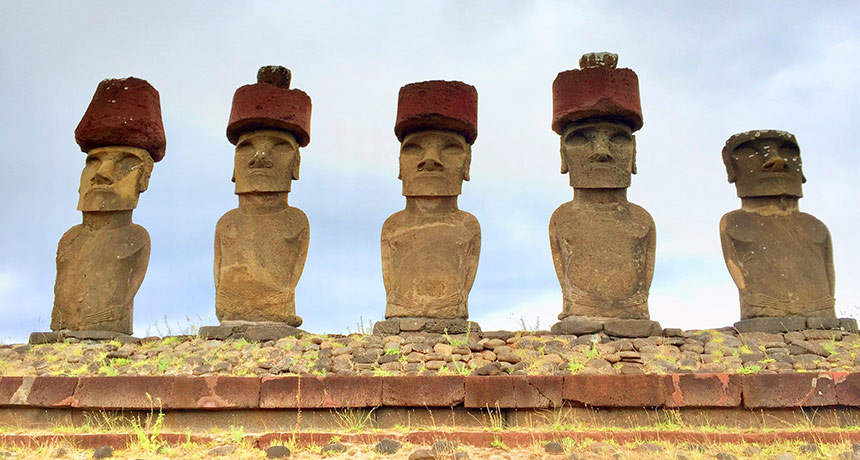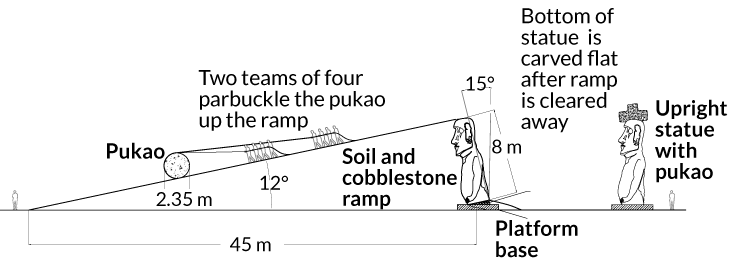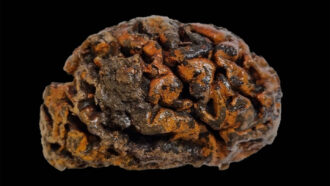Putting hats on Easter Island statues may have required some rock and roll
Small teams of people may have rolled stone cylinders up a ramp, then tipped them onto the stone heads

Colossal stone headgear placed atop some Easter Island statues may have been rolled up earthen ramps. Small groups of people could have moved them using only long ropes, a new analysis suggests.
C. Lipo
By Bruce Bower
How did the massive stone statues on Rapa Nui — better known as Easter Island — end up wearing stone hats? It may have taken ramps, ropes and a remarkably small workforce. That’s the finding of a new study. But not everyone buys its conclusion.
The largest of those hats are nearly two meters (6.6 feet) across and weigh some 12 metric tons (26,500 pounds). Many scientists had wondered how the statues got their massive headgear, which are made from a separate piece — and different type of stone — than each statue.
Polynesian travelers first settled the island by the 1200s. The 164-square-kilometer (63.3-square-mile) island sits in the Pacific Ocean, about midway between the west coast of Chile (in South America) and the Pacific island chain of Tahiti. Islanders made nearly 1,000 human statues from volcanic rock. These figures stand up to 10 meters (33 feet) tall and weigh as much as 74 metric tons (160,000 pounds). Hundreds of them were placed atop stone platforms, many on the island’s coast.
Sean Hixon is an archaeologist at Pennsylvania State University in University Park. He was part of a research team that has been studying the famous stone heads and their toppers, called pukao. The team focused on dozens of the hats.
The researchers looked for things the huge stone hats had in common that might explain how they had been made and moved. What they learned now suggests that the cylindrical headgear could have been rolled up ramps to the top of the statues. Then the stones could have been tipped over to sit upright atop the giant heads. It may have taken no more than 15 people to manage the feat, the researchers say.
They shared their analysis online May 31 in the Journal of Archaeological Science.
Earlier reports had proposed different scenarios
One earlier analysis had suggested that Rapa Nui inhabitants instead slid pukao up wooden ramps. Another proposed that pukao were placed atop the statues while those stone were lying down. Then, statue and hat might have been lifted upright together.
But such ideas did not always account for the details of the stones and the site, Hixon says. “Our group is the first to consider which pukao transport-and-placement scenario is most consistent with the archaeological record of these multi-ton objects.”
Study coauthor Carl Lipo is an archaeologist at Binghamton University in New York. Five years ago he led a team that described how the natives moved the giant statues. These researchers concluded that the islanders used ropes to rock upright statues back and forth. With enough rocking, the huge stones waddled down prepared dirt roads to their final resting sites.
As some statues fell along the way, the islanders left them on the side of the road. These left-behind rocks reveal clues to how they had been made. Bases of the fallen stones are not flat, but carved on a slight diagonal. That suggests the bases were not flattened until they reached their destination.
The pukao were carved from a distinctive red rock. The cylinders were likely laid on their sides and rolled down dirt roads to statue sites, Hixon’s team now says. Reddish rock chips scattered around the statues suggest the pukao were carved on-site into their final shape.
Rocks on a roll
That left the mystery: How were the pukao moved on the statues’ heads?
Ramps of soil and stones would have provided access to the tops of statues, Hixon’s group now proposes. Workers could have rolled those hats up the ramps with a technique called parbuckling. This involves wrapping a rope around a cylinder placed on its side. One of the rope’s ends would be anchored at or near the ramp’s top. It could be held in place by several people. Another group would have pulled on the rope’s free end to roll the cylinder uphill.
At the top of the ramp, the islanders could have tipped the pukao onto a statue’s head. It’s unclear, the researchers note, just how the tipping would have been done. They looked for clues on 3-D models of 10 pukao left at a quarry site. The cylinder bottoms all had shallow indents, they discovered. Those may have allowed a snug fit once atop the statue heads.
Once the pukao was in place, workers would have removed the ramp, then chipped the statues’ bases flat so that the figures would stand straight.
Story continues below image.

Archaeologist Jo Anne Van Tilburg does not find this explanation convincing. She is an expert on Rapa Nui statues at the University of California, Los Angeles. Base angles on the statues varied a lot, she says. That would make them difficult and dangerous to lift upright. Parbuckling the hats up long ramps would not have been efficient, she adds. It would not have reduced the total effort needed to get the massive cylinders atop the statues’ heads, she says.
More likely, she thinks, is that the statues and pukao were moved together. She directed a 1998 experiment testing such a plan. Her team used a tree-trunk frame to transport a replica stone statue and pukao to a display platform. The frame-encased replicas were laid down across the rungs of a wooden, ladderlike ramp. Then the team used ropes to pull the frame and statue up the ramp to the platform. Six to eight families could have completed this process, she estimates.
However the enormous statues and pukao were moved and set up, one thing seems clear, Lipo says: They were built by small communities rather than states or kingdoms. That is similar to other impressive ancient stone monuments, such as England’s Stonehenge.







